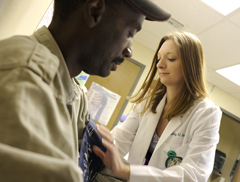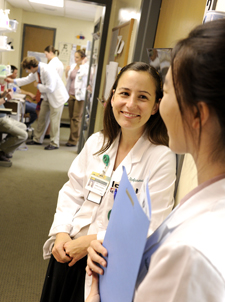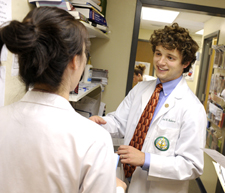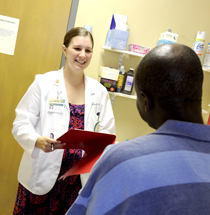Student Caregivers Help Underserved Patients
By Meghan Davis
 Equal Access Birmingham is a student-led volunteer organization at the UAB School of Medicine.When Marielle Baldwin was interviewing for a place at the UAB School of Medicine, she was intrigued by the opportunities students had to work in the state-of-the-art facilities at UAB Hospital and The Kirklin Clinic. But what attracted her most was the chance to work in a far less well-equipped building a few miles east of campus.
Equal Access Birmingham is a student-led volunteer organization at the UAB School of Medicine.When Marielle Baldwin was interviewing for a place at the UAB School of Medicine, she was intrigued by the opportunities students had to work in the state-of-the-art facilities at UAB Hospital and The Kirklin Clinic. But what attracted her most was the chance to work in a far less well-equipped building a few miles east of campus.
Baldwin previously served in AmeriCorps in Colorado, working as a health educator at a pediatric primary care clinic, which sparked an interest in primary care and in the larger issues of health care access and affordability. When she found out about Equal Access Birmingham (EAB), a student-run volunteer organization at the UAB School of Medicine, she was eager to get involved.
“It was important to choose a medical school where I could not only learn to become a physician but also interact with my community and take a public health approach,” says Baldwin, now a second-year student and EAB president.
Now in its seventh year, EAB has steadily added members, expanded its services to reach more local communities, and increased its fund-raising. By the end of the summer, the group plans to be able to open a free student-run clinic of its own. From its inception, EAB has planned a sustainable, freestanding clinic to ease the burden on the city’s emergency services and clinics and offer students a chance to help their community, says Baldwin.
Safety Net
UAB medical students formed Equal Access Birmingham in 2005 with the guidance of Craig Hoesley, M.D., professor of medicine and associate dean for undergraduate medical education. Two years later, they began staffing the M-POWER Ministries clinic in the Avondale neighborhood every Wednesday.
 Each Wednesday evening, EAB members volunteer at a free clinic run by Birmingham's M-POWER Ministries in Avondale.The clinic treats patients on a first-come, first-served basis. Due to limited resources, each patient can return up to three times in a year. “It’s a safety net, basically,” Baldwin says. “We’re treating chronic conditions in an acute care setting.”
Each Wednesday evening, EAB members volunteer at a free clinic run by Birmingham's M-POWER Ministries in Avondale.The clinic treats patients on a first-come, first-served basis. Due to limited resources, each patient can return up to three times in a year. “It’s a safety net, basically,” Baldwin says. “We’re treating chronic conditions in an acute care setting.”
Typically, three to five medical students see a dozen patients—taking vitals and performing exams under the supervision of volunteer doctors, many of them UAB faculty. “Many of our patients are living in shelters and working to get their lives on track,” says first-year student Elizabeth Varnell. “We listen to their stories and use the interviewing skills we learn in school to develop a picture of their illness or condition.”
Second-year students serve as officers and have traditionally comprised most of the volunteer pool, but group members see EAB becoming more integrated into the student experience. The organization currently boasts 50 percent participation from the first- and second-year classes.
Building a Bridge
In recent years, EAB students have branched out from the M-POWER clinic, staffing health screenings in shelters and community centers, Baldwin says. EAB also works with UAB’s Division of Preventive Medicine to develop diabetes education tools, and they host a biannual women’s health day in partnership with M-POWER Ministries, offering free gynecologic care to women in shelters.
“The majority of our programs focus on primary care and preventive health screenings for underserved populations,” Varnell says. “Because many of our patients have limited access to care, they have fallen through the cracks. We want to be a bridge for our community by empowering individuals, providing medical education and confronting barriers to health care.”
 EAB members also volunteer at screening days and at other Birmingham-area clinics.This year, EAB is rotating quarterly between locations in three neighborhoods. A continued presence allows students to keep records, address patients’ continuing concerns, and follow through with treatment plans. “People get to know us and grow to trust us,” Baldwin says.
EAB members also volunteer at screening days and at other Birmingham-area clinics.This year, EAB is rotating quarterly between locations in three neighborhoods. A continued presence allows students to keep records, address patients’ continuing concerns, and follow through with treatment plans. “People get to know us and grow to trust us,” Baldwin says.
Adopting a chronic-care model of disease is important, Baldwin explains. “Previously, we didn’t get to follow up with the same patients. Many of them have hypertension or diabetes. We might put them on a medication but never see them again.” The new clinic will help facilitate the transition to continuing care as well as provide a base of operations.
Eye-Opening and Encouraging
Seeing the community’s need and the reality of health disparities firsthand is often an eye-opening experience for medical students, Baldwin says. “There’s a huge population of underinsured and uninsured people,” she says. “Our neighbors are the ones who need health care the most.”
EAB also enables students to learn to apply their education in the field, an opportunity Varnell called “a rewarding reality check.”
Second-year student Peyton Nesmith agrees. “At its core, EAB challenges students to work together and develop innovative ways with limited resources to serve the community with basic health care and health-care education.”
Despite the challenges, the experience is an encouraging one, the students say. “Volunteering at the clinic can help renew a student's confidence in his or her education,” notes second-year student Anand Bosmia. “I remembered medical theory in greater detail after seeing the relevant disease state and having a practicing physician explain his or her logic in asking the patient certain questions and performing certain physical exams.” In addition, “volunteering helps us stay engaged with the human element of medicine,” he says.
 The EAB members are raising money to start their own clinic closer to UAB's campus. They raised more than $60,000 at the School of Medicine's annual Best Medicine Show in February, and are close to reaching their goal.Varnell began working with EAB during her first month of school, serving as a Spanish translator at the M-POWER clinic. Bosmia also started volunteering during his first year to gain early exposure to patients while working alongside physicians.
The EAB members are raising money to start their own clinic closer to UAB's campus. They raised more than $60,000 at the School of Medicine's annual Best Medicine Show in February, and are close to reaching their goal.Varnell began working with EAB during her first month of school, serving as a Spanish translator at the M-POWER clinic. Bosmia also started volunteering during his first year to gain early exposure to patients while working alongside physicians.
“A Huge, Huge Thing”
EAB’s fund-raising efforts received a major boost from the 2012 Best Medicine Show, an update to the medical school’s beloved annual Skit Night and talent show that is produced and run by the School of Medicine Student Senate. This year’s event, held on March 2 at the historic Alabama Theatre, involved more than 100 students and 30 sponsors. Proceeds from the event went to EAB; Dean Ray Watts and the School of Medicine matched the funds the students raised at the show, bringing the total for the night to $62,000. “It’s a huge, huge thing,” Baldwin says. “We’ve never had that much money.”
With the funding in hand, EAB is working to open its clinic and provide additional services to people seeking help. “EAB's momentum comes from the perfect combination of great leadership and great need,” Varnell says. “America and Alabama are facing major challenges regarding the future of health care, and both our community and university recognize this.”